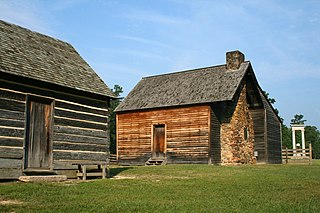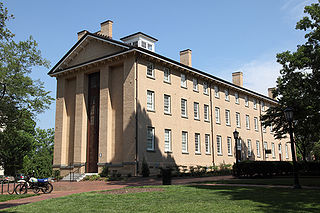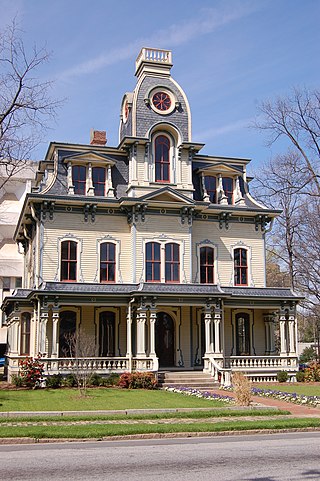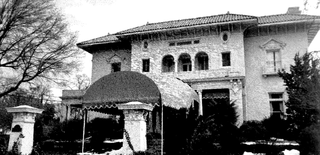
Bennett Place is a former farm and homestead in Durham, North Carolina, which was the site of the last surrender of a major Confederate army in the American Civil War, when Joseph E. Johnston surrendered to William T. Sherman. The first meeting saw Sherman agreeing to certain political demands by the Confederates, which were promptly rejected by the Union cabinet in Washington. Another meeting had to be held to agree on military terms only, in line with Robert E. Lee’s recent surrender to Ulysses S. Grant. This effectively ended the war.

Old East is a residence hall located at the north part of campus in University of North Carolina at Chapel Hill. Built in 1793 by slave labor, it became the first state university building in the United States. The Wren Building at the College of William & Mary in Williamsburg, Virginia, was built in 1695, but William and Mary did not become a public university until 1906.

The North Carolina State Capitol is the former seat of the legislature of the U.S. state of North Carolina which housed all of the state's government until 1888. The Supreme Court and State Library moved into a separate building in 1888, and the General Assembly moved into the State Legislative Building in 1963. Today, the governor and his immediate staff occupy offices on the first floor of the Capitol.

The Heck-Andrews House was finished in 1870 and was one of the first houses in Raleigh, Wake County, North Carolina to be constructed after the American Civil War. It is located at 309 North Blount Street. It was created by G.S.H. Appleget for Mrs. Mattie Heck, the wife of Colonel Jonathan McGee Heck. It is on the National Register of Raleigh Historic Property. The house has a dramatic central tower capped with a convex mansard roof with a balustrade. The central part of the 2+1⁄2-story, Second Empire style frame dwelling is enclosed with a concave mansard roof with patterned slate.
The Davis–Adcock Store is a historic general store located at Wilbon, North Carolina, a crossroads north of Fuquay-Varina, in Wake County, North Carolina. The building was constructed in 1906, and is a one-story, frame, gable-front building, with a standing-seam metal roof and a stepped-parapet false front. The community store served not only as a local distribution center for goods and services, but also as a center of community social life. The building also housed the local post office from 1906 until 1925.
The Frank and Mary Smith House is a historic home located at 2935 John Adams Road in Willow Spring, Wake County, North Carolina, a suburb of Raleigh. The house was built about 1880, and is a two-story, three-bay, single-pile frame I-house with a central hall plan. It is sheathed in weatherboard, has a triple-A-roof, and a 1+1⁄2-story tall shed addition and gabled rear ell.

Springfield Plantation House is the oldest wood-frame house in Fort Mill, South Carolina and was the site of one of the last meetings of the Confederate cabinet. It was listed on the National Register of Historic Places in 1985.
The Aycock Birthplace, also known as the Charles B. Aycock Birthplace, is a historic home in Wayne County, North Carolina, and a historic site belonging to the North Carolina Department of Natural and Cultural Resources' Historic Sites division. The property was the location of the birth of Governor Charles Brantley Aycock in 1859, and exhibits at the historic site serve to tell the story of the Governor's political career and the education reforms he enacted while in office. It was built about 1840, and is a one-story weatherboard dwelling on a brick pier foundation. It has a gable roof and exterior end chimneys.

Davis House is a historic plantation house located near Manning, Clarendon County, South Carolina.

John Alexander Lackey House is a historic home located at Morganton, Burke County, North Carolina. It was built about 1900, and is a two-story, "T"-shaped, gable roofed, brick farmhouse. It has a one-story, gabled kitchen wing. The house features Colonial Revival style detailing.
James Malone House is a historic home located near Leasburg, Caswell County, North Carolina. It was built in 1861, and is a two-story, three bays wide, Italianate style frame house on a brick foundation. It has a hipped roof and features a two-story pedimented entrance porch and brick end chimneys. The interior and exterior features woodwork attributed to noted African-American cabinetmaker Thomas Day.
Tyro Tavern, also known as Thompson House and Davis House, is a historic home located at Tyro, Davidson County, North Carolina. It was built about 1840, and is a two-story, five bay by three bay, Greek Revival style brick dwelling. It has a one-story, shed roofed rear porch.

Dr. David P. Weir House is a historic home located at Greensboro, Guilford County, North Carolina. It was built about 1846, and is a two-story, frame structure with Greek Revival and Italianate style design elements. It has a low hip roof pierced by two interior chimneys and a one-story kitchen wing. The house was expanded in 1961 by created a large meeting space at the front of the house for the Greensboro Woman's Club. The house may have been built from a plan provided by the well-known New York architect Alexander Jackson Davis.

John H. Adams House, also known as Davis Funeral Home, is a historic home located at High Point, Guilford County, North Carolina. It was built in 1918, and is a two-story, five bay, stuccoed frame structure in the Italian Renaissance style. It has a low pitched, deck-hipped roof with terra cotta, widely overhanging boxed eaves, and a three-bay recessed upper porch or loggia with semi-circular arches.

Davis Family House, also known as the Davis-Forbes House, is a historic home located near Crabtree, Haywood County, North Carolina. It was built about 1880, and is a 1+1⁄2-story, two-room plan frame dwelling sheathed in weatherboard. It was expanded by a shed-room addition in 1925–1926. The front facade features a one-story hip-roof porch.
McClelland-Davis House is a historic home located near Statesville, Iredell County, North Carolina. The house was built about 1830, and is a two-story, five bay by two bay, transitional Federal / Greek Revival style frame dwelling. It has a gable roof, one-story rear wing, and two single shoulder brick end chimneys. Also on the property are the contributing smokehouse and well house.

Sutton-Newby House is a historic plantation house located near Hertford, Perquimans County, North Carolina. It was built about 1745, and is a 1+1⁄2-story, four-bay, frame dwelling with a brick end and gable roof. It originally had both ends in brick. It features a full-width, shed roofed front porch and massive double-shouldered chimney. It is a member of the small group of 18th century frame houses with brick ends in northeast North Carolina; the group includes the Myers-White House and the Old Brick House.

John Steele House, also known as Lombardy, is a historic plantation house located at Salisbury, Rowan County, North Carolina. It was built between 1799 and 1801, and is a two-story, three-bay, side hall plan, Federal style frame dwelling. It has a side gable roof, one-story shed roof porch, and is sheathed with beaded weatherboards. The house was restored between 1977 and 1983. It was the home of North Carolina politician John Steele (1764-1815).

Davis-Whitehead-Harriss House is a historic home located at Wilson, Wilson County, North Carolina. It was built in 1858, and renovated in 1872 in the Italianate style. It is a two-story, three bays wide, "T"-plan, frame dwelling, with a rear ell. It has single-shouldered, brick end chimneys with stuccoed stacks and a one-story, hipped roof front porch. Also on the property is a two-story frame carriage house built in 1925.

Clark-Miller Roller Mill, also known as the Davis-Clark Roller Mill and W.M. Miller Roller Mill, is a historic roller mill located near Lansing, Ashe County, North Carolina. It was built about 1915, and is a two- to three-story, banked frame with weatherboard siding and a metal roof. It rests on a poured concrete foundation and has a side-gabled roof. The building houses an Anglo-American (Midget) Marvel brand roller mill.


















